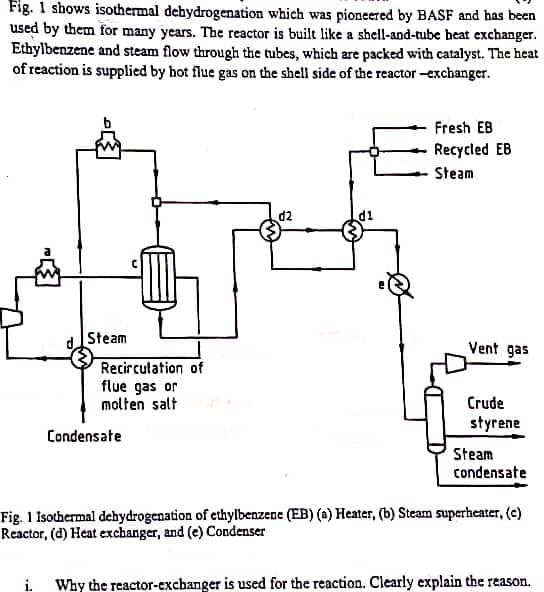Fig. 1 shows isothermal dehydrogenation which was pioneered by BASF and has been used by them for many years. The reactor is built like a shell-and-tube heat exchanger. Ethylbenzene and steam flow through the tubes, which are packed with catalyst. The heat of reaction is supplied by hot flue gas on the shell side of the reactor-exchanger. d2 Fresh EB Recycled EB Steam Steam Recirculation of flue gas or molten salt Condensate Vent gas Crude styrene Steam condensate Fig. 1 Isothermal dehydrogenation of ethylbenzene (EB) (a) Heater, (b) Steam superheater, (c) Reactor, (d) Heat exchanger, and (e) Condenser Why the reactor-exchanger is used for the reaction. Clearly explain the reason.
Fig. 1 shows isothermal dehydrogenation which was pioneered by BASF and has been used by them for many years. The reactor is built like a shell-and-tube heat exchanger. Ethylbenzene and steam flow through the tubes, which are packed with catalyst. The heat of reaction is supplied by hot flue gas on the shell side of the reactor-exchanger. d2 Fresh EB Recycled EB Steam Steam Recirculation of flue gas or molten salt Condensate Vent gas Crude styrene Steam condensate Fig. 1 Isothermal dehydrogenation of ethylbenzene (EB) (a) Heater, (b) Steam superheater, (c) Reactor, (d) Heat exchanger, and (e) Condenser Why the reactor-exchanger is used for the reaction. Clearly explain the reason.
Introduction to Chemical Engineering Thermodynamics
8th Edition
ISBN:9781259696527
Author:J.M. Smith Termodinamica en ingenieria quimica, Hendrick C Van Ness, Michael Abbott, Mark Swihart
Publisher:J.M. Smith Termodinamica en ingenieria quimica, Hendrick C Van Ness, Michael Abbott, Mark Swihart
Chapter1: Introduction
Section: Chapter Questions
Problem 1.1P
Related questions
Question
pls read the question carefully, i posted the same question more than one time but with different requirement. the subject name is Process plant design and safety, it's chemical engineering subject

Transcribed Image Text:Fig. 1 shows isothermal dehydrogenation which was pioneered by BASF and has been
used by them for many years. The reactor is built like a shell-and-tube heat exchanger.
Ethylbenzene and steam flow through the tubes, which are packed with catalyst. The heat
of reaction is supplied by hot flue gas on the shell side of the reactor -exchanger.
Fresh EB
Recycled EB
Steam
d2
Steam
Vent gas
Recirculation of
flue gas or
molten salt
Crude
styrene
Condensate
Steam
condensate
Fig. 1 Isothermal dehydrogenation of ethylbenzene (EB) (a) Heater, (b) Steam superheater, (c)
Reactor, (d) Heat exchanger, and (e) Condenser
i. Why the reactor-exchanger is used for the reaction. Clearly explain the reason.
Expert Solution
This question has been solved!
Explore an expertly crafted, step-by-step solution for a thorough understanding of key concepts.
Step by step
Solved in 4 steps

Recommended textbooks for you

Introduction to Chemical Engineering Thermodynami…
Chemical Engineering
ISBN:
9781259696527
Author:
J.M. Smith Termodinamica en ingenieria quimica, Hendrick C Van Ness, Michael Abbott, Mark Swihart
Publisher:
McGraw-Hill Education

Elementary Principles of Chemical Processes, Bind…
Chemical Engineering
ISBN:
9781118431221
Author:
Richard M. Felder, Ronald W. Rousseau, Lisa G. Bullard
Publisher:
WILEY

Elements of Chemical Reaction Engineering (5th Ed…
Chemical Engineering
ISBN:
9780133887518
Author:
H. Scott Fogler
Publisher:
Prentice Hall

Introduction to Chemical Engineering Thermodynami…
Chemical Engineering
ISBN:
9781259696527
Author:
J.M. Smith Termodinamica en ingenieria quimica, Hendrick C Van Ness, Michael Abbott, Mark Swihart
Publisher:
McGraw-Hill Education

Elementary Principles of Chemical Processes, Bind…
Chemical Engineering
ISBN:
9781118431221
Author:
Richard M. Felder, Ronald W. Rousseau, Lisa G. Bullard
Publisher:
WILEY

Elements of Chemical Reaction Engineering (5th Ed…
Chemical Engineering
ISBN:
9780133887518
Author:
H. Scott Fogler
Publisher:
Prentice Hall


Industrial Plastics: Theory and Applications
Chemical Engineering
ISBN:
9781285061238
Author:
Lokensgard, Erik
Publisher:
Delmar Cengage Learning

Unit Operations of Chemical Engineering
Chemical Engineering
ISBN:
9780072848236
Author:
Warren McCabe, Julian C. Smith, Peter Harriott
Publisher:
McGraw-Hill Companies, The